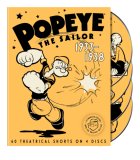| Reviews & Columns |
|
Reviews DVD TV on DVD Blu-ray 4K UHD International DVDs In Theaters Reviews by Studio Video Games Features Collector Series DVDs Easter Egg Database Interviews DVD Talk Radio Feature Articles Columns Anime Talk DVD Savant Horror DVDs The M.O.D. Squad Art House HD Talk Silent DVD
|
DVD Talk Forum |
|
|
| Resources |
|
DVD Price Search Customer Service #'s RCE Info Links |
|
Columns
|
|
|
Popeye the Sailor: 1933-1938, Vol. 1
THE SHOW:
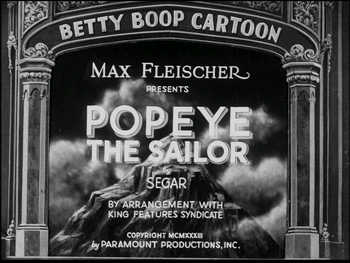
Popeye is one of those rare characters in popular culture that is almost universally recognized. Wherever you might go in this world, it probably won't take you long to find someone that can describe the character to you, tell you who his friends are, and maybe even sing his theme song. Spawned from the comic strip by E.C. Segar, the character winnowed his way deepest into the public consciousness through the cartoon shorts created by Max and Dave Fleischer's animation crew for Paramount Studios, gaining popularity on the silver screen that would carry over to new generations through years of television syndication.
Warner Bros. has now put together sixty of the earliest Popeye cartoons for the four-DVD set, Popeye the Sailor, 1933-1938: Volume One. For as much as I thought I knew about the Popeye cartoon series, it didn't take me long to realize that my knowledge was actually quite small. A lot of these cartoons, which are almost exclusively in black-and-white, probably never made it into the TV packages, at least not when I was young. This means a good portion of us are getting to travel back to the cartoon roots of the character and see his cinema beginnings for the very first time.
Things start off with the self-titled "Popeye the Sailor," which pretty much sets up the Popeye formula while also hedging the studio's bets by putting a Betty Boop musical number in the midst of the story for good measure (it's actually Betty's name on the main title card). Mumbling seaman Popeye, he of the elephantitis arms, takes his ultra skinny girlfriend, Olive Oyl, to the fair, where they watch the freakshow and encounter a hairy bully named Bluto. Bluto harasses the couple, both marveling at Popeye's ridiculous strength while also giving the old salt the runaround. Once he's at his breaking point, however, Popeye downs a can of spinach and gives Bluto the what for.
The cartoons that follow over DVD 1 rarely deviate from this very simple idea, except to maybe pit Popeye against a different antagonist, such as the natives in "I Yam What I Yam" or the trapeze artist in "The Man on the Flying Trapeze." As formulaic as this may sound, it doesn't matter a whit, because the repetition of idea is the most entrancing aspect of Popeye cartoons. You watch them to see him tussle with adversity, waiting patiently for his anger to come to a boil and him to gulp down that Spinach. It's the origin of the nonstop loop of violence that The Simpsons parodied in their "Itchy 'n' Scratchy" cartoons. You know who is going to take a licking, the pleasure is in finding out how. Popeye is the little guy that no one gives full estimation to, and yet he plants one on the chin of the man every time.
Even beyond the stories, though, there is a visual flow to these early cartoons that is revelatory. Working from the Segar designs, the Fleischer team created a more liquid, boldly rendered version of the characters. It's quite novel to see them in the early years, surrounded by the less-developed, more generic hoi polloi that filled out the Fleischer crowd. Popeye and his entourage stand completely apart. Yet, all the pictures move with the same inky ease. Much of the other work from other animation houses from the same period pales by comparison.
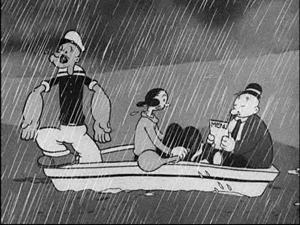
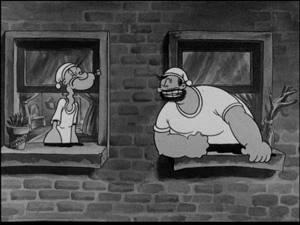
You'd be wrong to think that the stories are just Popeye and Bluto whaling on one another, however. I mean, that is what they are doing. Whether the pair are roughriders in the rodeo or blacksmiths trying to impress the girl, they pound the living daylights out of each other. It's what the animators come up with for them to do in these battles that makes them so awesome. Someone along the way said, "These are cartoons, and they don't have to be bound by the laws of physics like live action," and this freed the animators to be endlessly creative. In the first couple of cartoons alone, Popeye catches lightning bolts that threaten to strike his little rowboat (masochistically rowed by Olive as Popeye stands at the front and Wimpy reclines in the back), and in one brawl, when his head hits a rock, the stone first shatters like an egg before turning to a pile of smaller rocks. At the rodeo, Bluto and Popeye disassemble and reassemble their horses and the animals switch direction simply by having their tails and heads swap places. It's this kind of violent surreality that the filmmakers can build on time and again. (Even the world around them isn't bound by any conventional wisdom. In "Shoein' Hosses," for instance, the tree outside Olive Oyl's business leans on the house the way a person would lean against a wall.)
The apex of these rumbles is the knock-down drag-out free-for-all in "Can You Take It." Popeye goes to join the Bruiser Boy's Club, an organization formed by Bluto and a gaggle of thugs so that they can torture hapless nitwits who try to join. It's the ultimate in hazing and initiation rituals, the kind of stuff Eli Roth only wishes he could dream up, a gauntlet of increasingly deadly obstacles that, naturally, are no match for the iron-jawed spinach eater. (Though, the most perverse torture is reserved for Olive Oyl just a few cartoons later, when she, Popeye, and Wimpy end up on the haunted ship in "Shiver Me Timbers!" The ghosts tie Olive down so she can't move her arms or legs and let kitty cats lick her feet!)
Evolution is a slow process in the Fleischer Popeyes, but it does start to creep in on DVD 2. The main thing is a slight shift in the love triangle. Rather than just being the aggressor, Bluto actually begins to be a welcome presence in Olive's life, and the two suitors fight over who gets to date the skinny dame. She quite literally pits them against one another in cartoons like "Beware of Barnacle Bill," and her fickleness is even kind of mean. In "Pleased to Meet Cha!" both men show up at her house at the same time, and seeing that letting them both stick around is going to end badly, Olive says one must depart but leaves which one up to them. Popeye and Bluto then try to outdo one another in a series of dangerous "tricks," and as plates smash against their heads and they bounce each other off walls, Olive Oyl laughs hysterically. Of course, with things suddenly malleable, we also get to see Popeye reject the temptress ("For Better or Worser") and even try to be friendly partners with the betraying Bluto ("Dizzy Divers"). (Wimpy and Bluto have a one-time team-up in "What - No Spinach?" too.)
"Dizzy Divers" also contains an excellent formalist joke, one of many such gags in the series. Popeye and Bluto plot their course on a treasure map, and Popeye lifts up the X that marks the spot, and underneath is a picture of the sunken ship. He then lifts that and underneath is an image of the treasure chest. It's like a mini-montage of zooms, but all within the physical plane occupied by the characters. The free-wheelin' style I previously noted allowed for such expansions. On DVD 2, we also see Popeye mixing with live action in "Adventures of Popeye," which could quite possibly be the first ever "clip show." Right after, "The Spinach Overture" shows Popeye and Bluto competing musically, each trying to prove their melodic muscle as conductors. While they had dueled via song before ("King of the Mardi Gras," for example), this is the first time it's completely through music.
Which is surprising, as music has always been an important component of the Popeye cartoons. In the very first, he even dances with a scantily clad Betty Boop. The Popeye cartoons are cut to a then very modern jazz rhythm, and many of the cartoons contained both original songs and popular tunes of the day. And, of course, there is Popeye's ever-present theme, which starts just about every short and then comes trumpeting back as he eats his spinach.
The further evolution of the series involves the slow introduction of other characters. "Little Swee'Pea" introduces the mischievous baby who obliviously crawls into one trouble spot after another (this time at a zoo; in "Lost and Foundry," a factory). We also get to see Popeye and the gang as youngsters in "The Football Toucher Down." Other characters like Poopdeck Pappy and Eugene the Jeep had not yet made it out of the newspaper by 1938, alas.
A more obvious advance is the introduction of color. During this period, the Fleischers made two "two-reelers," so called because they were twice as long as the average cartoon and took two reels of films to contain. These early forays into Technicolor are remarkable from an artistic stand-point. The studio was still doing some of their 3-dimensional models for backgrounds (a signature technique of the innovative studio), and more pastel-based tones were used for the sets while the characters were brighter, popping more. To deal with the stretched script length, these cartoons--the Oscar-nominated "Popeye the Sailor Meets Sindbad the Sailor" and "Popeye the Sailor Meets Ali Baba's Forty Thieves"--have a greater focus on story. The Fleischers put him in familiar tales that they coule exploit for their uniqueness in relation to their scrappy seaman. It also gives the songs more room to breathe, allowing for more traditional musical numbers that are used to advance the plot.
Popeye the Sailor, 1933-1938: Volume One is a pretty impressive run in cartoon history. I am not sure there is another series that can match it for volume and consistency of product. There's not really a bummer here in the pack, every short is full of wondrous sights and funny gags. It's the magical chemistry of the Segar comics and the Fleischers' singular approach to cartoons that did it, a combination that can never be replicated.
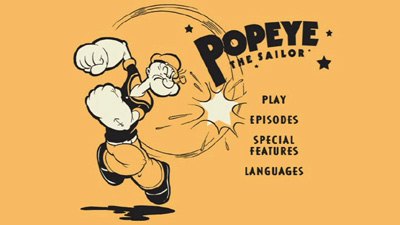
The full list of cartoons on DVD 1:
Popeye the Sailor * I Yam What I Yam * Blow Me Down! * I Eats My Spinach * Seasin's Greetinks! * Wild Elephinks * Sock-A-Bye, Baby * Let's You and Him Fight * The Man on the Flying Trapeze * Can You Take It * Shoein' Hosses * Strong to the Finich * Shiver Me Timbers! * Axe Me Another * A Dream Walking
The full list of cartoons on DVD 2:
The Two-Alarm Fire * The Dance Contest * We Aim to Please * Beware of Barnacle Bill * Be Kind to 'Animals' * Pleased to Meet Cha! * The "Hyp-Nut-Tist" * Choose Yer 'Weppins' * For Better or Worser * Dizzy Divers * You Gotta Be a Football Hero * King of the Mardi Gras * Adventures of Popeye * The Spinach Overture * Vim, Vigor and Vitaliky
The full list of cartoons on DVD 3:
A Clean Shaven Man * Brotherly Love * I-Ski Love-Ski You-Ski * Bridge Ahoy! * What - No Spinach? * I Wanna Be a Life Guard * Let's Get Movin' * Never Kick a Woman * Little Swee'Pea * Hold The Wire * Popey the Sailor Meets Sindbad the Sailor (Color) * I'm in the Army Now * The Paneless Window Washer * Organ Grinder's Swing
The full list of cartoons on DVD 4:
My Artistical Temperature * Hospitaliky * The Twisker Pitcher * Morning, Noon and Nightclub * Lost and Foundry * I Never Changes My Altitude * I Likes Babies and Infinks * The Football Toucher Down * Protek the Weakerist * Popeye the Sailor Meets Ali Baba's Forty Thieves (Color) * Fowl Play * Let's Celebrake * Learn Polikeness * The House Builder-Upper * Big Chief Ugh-Amugh-Ugh
THE DVD
Video:
All the cartoons are presented in full frame. The studio has done a fairly conscientious job of preparing the sixty shorts for DVD. The image quality is mainly crisp and authored properly, with a sliding scale for how clean the print is. Some of the cartoons are still scratched up, with some (such as "Shiver Me Timbers!" and "Axe Me Another;" the flickery "I Never Changes My Altitude") being noticeably worse than others. But even those are relatively forgivable, and it's hard to say if it's negligence or just the drawback of the material available.
The two color cartoons are brightly rendered and look really nice, even though there is a little flicker on some of the frames. The colors really shine through.
Sound:
The soundtracks for the toons are also nicely cleaned, with very little hiss or surface noise. The mixes are in mono.

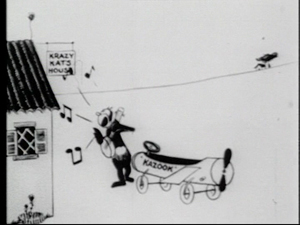
Extras:
As with most of the Warner Bros. cartoon sets, you can pick and choose your cartoons or play them all straight through in order. There are also plenty of extra features on each disc, but they also serve to connect the different DVDs.
For instance, DVDs 1 and 2 each have a lengthy documentary. On the lead disc, it's "I Yam What I Yam: The Story of Popeye the Sailor Man" (43 minutes, 20 seconds), which details the history of the character from his comic strip origins (they were ultimately very different) and the many years of cartoons, how the stories and the cast changed, and how the behind the scenes people brought different things, leading us right up to the computer animated present. Many of the commentators, including historians, children of members of the animation team, and representatives of King Features are the ones who show up in all the other documentary featurettes. Some of the bigger guests include cartoonist and writer Jules Feiffer; Mutts creator Patrick McDonnell, Sam Viviano, an art director at MAD Magazine; voice actor Billy West; Dennis Franz and Paul Dooley, both of whom were in the live-action Popeye; Mort Walker, the creator of Beetle Bailey; and cartoonist Stephen DeStefano, who did the amazing artwork on the tri-fold inner sleeve and the outer slipcase for Popeye the Sailor, volume 1. (Disclosure: I also count DeStefano as a friend; you should visit his art blog.) The companion piece to this is the fascinating feature on Disc 2, the documentary "Forging the Frame: The Roots of Animation 1900-1920" (31 minutes). This short film traces the invention of cartoons and how the form evolved in the early years, leading up to the Fleischers and the invention of the Rotoscope. In addition to some of the previous scholars, film director Terry Gilliam and stop-motion pioneer Ray Harryhausen talk about their affection for old cartoons.
To go with that historical documentary, each disc gives us a handful of cartoons from that early period. On DVD 1, it's three silent shorts from the Bray Productions/IFC studios, "Colonel Heeza Liar at the Bat" (1915), "Krazy Kat Goes A-Wooing" (1916), and "Domestic Difficulties" (1916), starring Mutt and Jeff. These black-and-white clips play totally silent, no music tracks at all, and include both narrative title cards and balloons that pop up like comic strip dialogue. On DVD 2, three more shorts from the Brays and the Sullivan studios get trotted out, and they are "Bobby Bumps Puts a Beanery on the Bum" (1918), "Feline Follies" (the first Felix the Cat from 1919), and "The Tantalizing Fly" (an early Koko the Clown, also from 1919).
The cartoons on the last two discs take us into the early Fleischer days and their "Out of the Inkwell" shorts. DVD 3 has six of them spanning 1921 to 1923: "Modeling," "Invisible Ink," "Bubbles," "Jumping Beans," "Bedtime," and "Trapped." These are experimental films combining animation with live action, with even a little stop-motion thrown in for good measure. The "Put of the Inkwell" series primarily involved Koko, a rebellious cartoon character, interacting with his animator, leaping off the paper to cause all kinds of mischief. Three more Koko silents show up on DVD 4: "A Trip To Mars" (1924), "Koko Trains 'em" (1925), and "Koko Back Tracks" (1927). The last of the vault cartoons on DVD 4 is 1933's "Let's Sing with Popeye," a reuse of one of his performances of his theme song attached to a follow-the-bouncing-ball singalong.
In addition to the longer documentaries, all four DVDs have two short featurettes, running from four to ten minutes, called Popeye Popumentaries. These are cut form the same cloth as "I Yam What I Yam" and their titles pretty much tell you what their subjects are: "Mining the Strip: Elzie Segar and Thimble Theatre" and "Me Fickle Goyl, Olive Oyl: The World's Least Likely Sex Symbol" on Disc 1; "Wimpy the Moocher: Ode to the Burgermeister" and "Sailor's Hornpipes: The Voice of Popeye" on Disc 2; "Blow Me Down! The Music of Popeye" and "Popeye in Living Color: A Look at the Color Two-Reelers" on Disc 3; and "Me Lil' Swee'Pea: Whose Kid is He Anyway?" and "Et Tu, Bluto? Cartoondom's Heaviest Heavy" on DVD 4. These more focused bonuses are just as informative as the longer ones, with only a minimum of crossover.
Finally, in addition to these features, there is a rotating roster of commentators who provide extra audio tracks on a handful of cartoons on each disc. These are mainly scholars and current animators, all of whom really enjoy the cartoons they are speaking about and often bring in critical articles about the shorts they can quote from or even old audio from some of the cartoon's makers, which makes for illuminating chats. These people are:
* Historian Michael Barrier on "Popeye the Sailor" and "I Eats My Spinach" (with old audio featuring animator Dave Tendlar) on DVD 1, "King of the Mardi Gras" (with vintage audio of Popeye voice actor Jack Mercer) on DVD 2,
* Animator Mark Kausler on "I Yam What I Yam" (DVD 1) and "The Paneless Window Washer (DVD 3)
* Animation duo Jorge Gutierrez and Sandra Equihua on "Blow Me Down!" (DVD 1)
* Leading animation chronicler Jerry Beck on "Wild Elephinks" (DVD 1), "Beware of Barnacle Bill" and "You Gotta Be a Footbal Hero" (DVD 2), "Protek the Weakerest" (DVD 4)
* Historian Glenn Mitchell on "Sock-a-Bye Baby" (DVD 1), "Adventures of Popeye" (DVD 2)
* Filmmaker Greg Ford on "Can You Take It" (DVD 1), "Choose Yer 'Weppins'" and "For Better or Worser" (DVD 2)
* Director Eric Goldberg on "A Dream Walking" (DVD 1)
* Music expert Daniel Goldmark on "The Spinach Overture" (DVD 2)
* Writer Paul Dini on "A Clean Shaven Man" (DVD 3)
* Ren & Stimpy creator John Kricfalusi forms a chaotic team with Eddie Fitzgerald and Kali Fontecchio on "I-Ski Love-Ski You-Ski" and "Sindbad the Sailor" (DVD 3) and "Lost and Foundry" and "Ali Baba's Forty Thieves" (DVD 4)
The commentaries do get redundant when it comes to the basic information (origins of the character, who did the voices, etc.), but overall, they are informative and lively.
DVD 4 is the only in the set to have trailers, a few of which run as the disc loads (but can be skipped with your "menu" button) and a few that can be accessed via the special features section.
FINAL THOUGHTS:
Popeye the Sailor, 1933-1938: Volume One has sixty cartoons, representing five years of hilarity and some of the best that early animation has to offer. The Popeye shorts are unmatched in animation history, with the Fleischer Studios creating a sustained run of comedy shorts without ever losing their original bite or abandoning their drive to find new ways of expression. Warner Bros. has produced a fine set here, presenting clean prints of the cartoons, as well as supplemental material that is truly fascinating and should make any animation buff beam with joy. This gets ranked in the DVD Talk Collector Series, our highest honor. Every collection should have Popeye the Sailor, 1933-1938: Volume One.
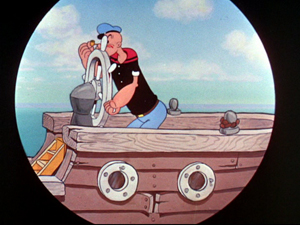
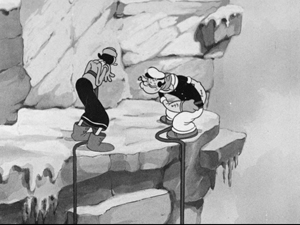
Jamie S. Rich is a novelist and comic book writer. He is best known for his collaborations with Joelle Jones, including the hardboiled crime comic book You Have Killed Me, the challenging romance 12 Reasons Why I Love Her, and the 2007 prose novel Have You Seen the Horizon Lately?, for which Jones did the cover. All three were published by Oni Press. His most recent projects include the futuristic romance A Boy and a Girl with Natalie Nourigat; Archer Coe and the Thousand Natural Shocks, a loopy crime tale drawn by Dan Christensen; and the horror miniseries Madame Frankenstein, a collaboration with Megan Levens. Follow Rich's blog at Confessions123.com.
|
| Popular Reviews |
| Sponsored Links |
|
|
| Sponsored Links |
|
|
| Release List | Reviews | Shop | Newsletter | Forum | DVD Giveaways | Blu-Ray | Advertise |
|
Copyright 2024 DVDTalk.com All Rights Reserved. Legal Info, Privacy Policy, Terms of Use,
Manage Preferences,
Your Privacy Choices | |||||||









